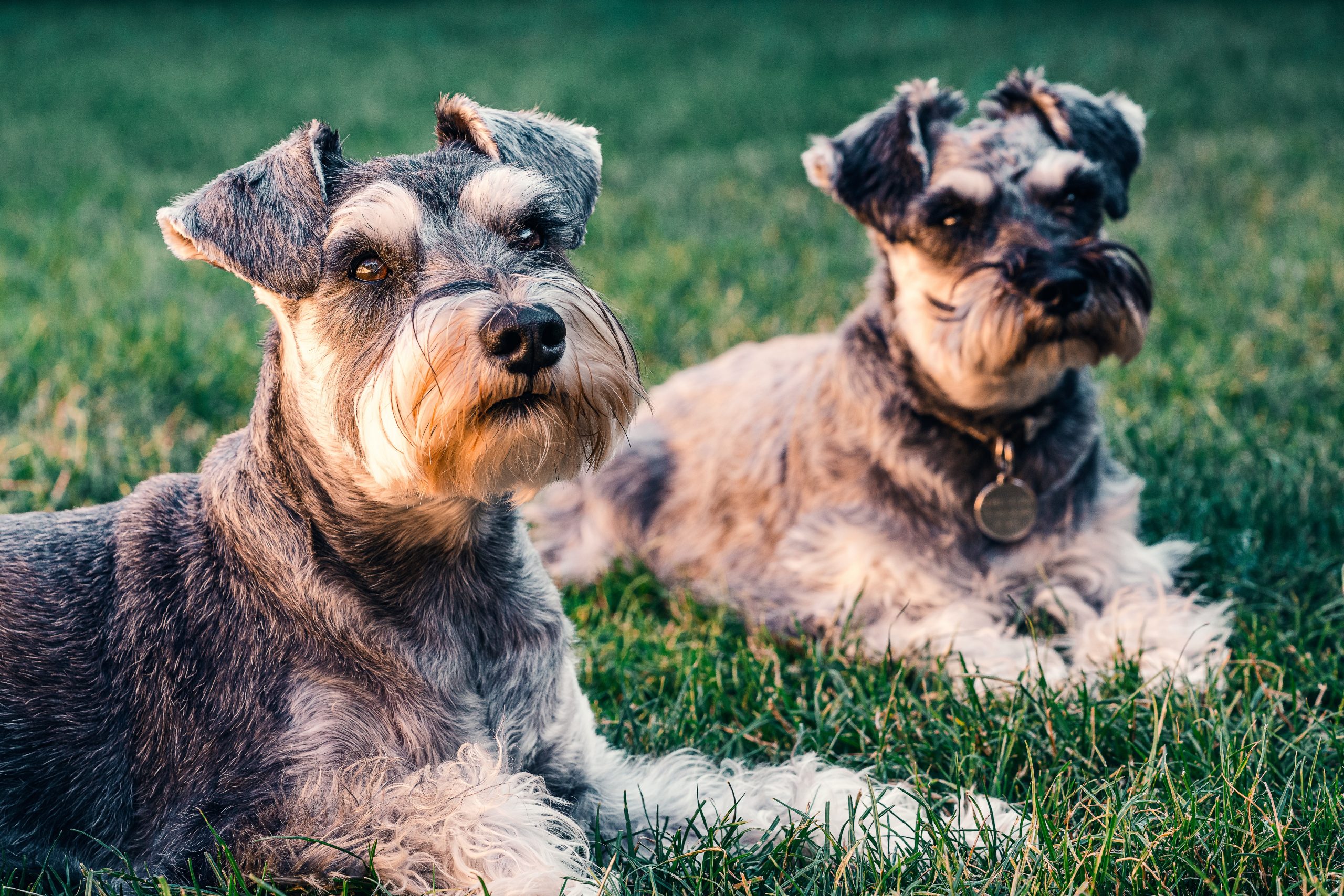From their distinctive bearded faces to their spirited personalities, Schnauzers are beloved by many. As they transition from tiny pups to confident adults, understanding their growth patterns is pivotal for any dedicated owner. This article unveils the captivating trajectory of Schnauzer puppies, delving into their average weights and heights at various stages. Whether you’re a prospective owner or merely intrigued by this charismatic breed, our guide will provide valuable insights into the formative months of Schnauzers. Join us as we chart the evolution of these delightful canines, from miniature pups to their full-fledged stature.
 Male Schnauzer Weights & Heights by Age
Male Schnauzer Weights & Heights by Age
The following chart contains the average weights and heights of a male Schnauzer from newborn to 3 years of age. Please note these are only averages. Always consult with your veterinarian if you have any concerns about your Schnauzer’s growth.
| Age | Weight (lbs) | Weight (kg) | Height (inches) | Height (cm) |
|---|---|---|---|---|
| 0 – 1 month | 2 – 5 | 0.9 – 2.3 | 4 – 6 | 10 – 15 |
| 2 months | 5 – 10 | 2.3 – 4.5 | 6 – 9 | 15 – 23 |
| 3 months | 10 – 15 | 4.5 – 6.8 | 8 – 11 | 20 – 28 |
| 4 months | 15 – 20 | 6.8 – 9.1 | 10 – 13 | 25 – 33 |
| 5 months | 20 – 25 | 9.1 – 11.3 | 12 – 15 | 30 – 38 |
| 6 months | 25 – 30 | 11.3 – 13.6 | 14 – 17 | 36 – 43 |
| 7-9 months | 30 – 35 | 13.6 – 15.9 | 16 – 18.5 | 41 – 47 |
| 10-12 months | 35 – 40 | 15.9 – 18.1 | 17.5 – 19 | 44 – 48 |
| 2 years old | 35 – 45 | 15.9 – 20.4 | 18 – 20 | 46 – 51 |
| 3 years old | 36 – 45 | 16.3 – 20.4 | 18 – 20 | 46 – 51 |
Female Schnauzer Weights & Heights by Age
The following chart contains the average weights and heights of a female Schnauzer from newborn to 3 years of age. Please note these are only averages. Always consult with your veterinarian if you have any concerns about your Schnauzer’s growth.
| Age | Weight (lbs) | Weight (kg) | Height (inches) | Height (cm) |
|---|---|---|---|---|
| 0 – 1 month | 1.5 – 4.5 | 0.7 – 2 | 3.5 – 5.5 | 9 – 14 |
| 2 months | 4.5 – 9 | 2 – 4.1 | 5.5 – 8 | 14 – 20 |
| 3 months | 9 – 14 | 4.1 – 6.4 | 7.5 – 10.5 | 19 – 27 |
| 4 months | 14 – 19 | 6.4 – 8.6 | 9.5 – 12.5 | 24 – 32 |
| 5 months | 19 – 24 | 8.6 – 10.9 | 11.5 – 14.5 | 29 – 37 |
| 6 months | 23 – 28 | 10.4 – 12.7 | 13.5 – 16.5 | 34 – 42 |
| 7-9 months | 27 – 32 | 12.2 – 14.5 | 15 – 17.5 | 38 – 44 |
| 10-12 months | 30 – 35 | 13.6 – 15.9 | 16.5 – 18.5 | 42 – 47 |
| 2 years old | 30 – 37 | 13.6 – 16.8 | 17 – 19 | 43 – 48 |
| 3 years old | 31 – 37 | 14 – 16.8 | 17 – 19 | 43 – 48 |
These tables are based on general guidelines and can vary greatly depending on individual dogs. Always consult with a veterinarian or professional breeder for more specific information about your pet’s growth and development.
FAQs about a Schnauzer Puppy’s Growth and Development
- 1. How fast will my Schnauzer puppy grow? While Schnauzers grow most rapidly in their first six months, growth can continue until they reach about a year old. Their breed (Miniature, Standard, or Giant) significantly affects their growth rate, with each variety reaching its mature size at a different age.
2. What is the average adult size of a Schnauzer? The Schnauzer breed has three sizes. Miniatures typically weigh 10-15 lbs and stand 12-14 inches tall, Standards weigh 30-50 lbs and stand 17.5-19.5 inches tall, and Giants can weigh 55-85 lbs and stand 23.5-27.5 inches tall.
3. When will my Schnauzer’s growth plates close? Schnauzer growth plates generally close between 12 to 18 months. Giant Schnauzers may take a bit longer, possibly up to 24 months. It’s crucial not to subject them to heavy exercise until their growth plates have closed to avoid injury.
4. Is it normal for my Schnauzer puppy to have a growth spurt? Yes, like many breeds, Schnauzers can experience growth spurts, especially during their first six months. You might notice them becoming leggier or filling out in short periods.
5. How do I know if my Schnauzer is underweight or overweight? You should be able to feel their ribs easily without pressing hard but shouldn’t see them. If the waist is distinct when viewed from above and the abdomen tucks up from the side, your Schnauzer is likely at a healthy weight.
6. How much should I feed my growing Schnauzer puppy? Always follow the recommended serving sizes on puppy food labels, adjusting based on your puppy’s activity level. Consult with your vet about the best diet and portion sizes.
7. Do male and female Schnauzers grow at the same rate? Generally, male Schnauzers might grow slightly faster and end up larger than their female counterparts. However, individual growth can vary.
8. How long should my Schnauzer puppy’s legs be at 6 months? While it varies among the breed types, Schnauzer puppies will typically have longer legs relative to their body at 6 months. They may look a bit gangly during this phase before filling out.
9. When will my Schnauzer puppy get its adult coat? By 6-8 months, your Schnauzer will start transitioning from their soft puppy coat to their rougher, denser adult coat. Regular grooming helps manage this change.
10. Can neutering or spaying affect my Schnauzer’s growth? Yes, early spaying or neutering can potentially affect growth, causing the dog to grow taller. Discuss the best timing for these procedures with your veterinarian.
11. Are Schnauzers late bloomers in terms of growth? While most of their growth occurs in the first year, they can continue filling out and maturing until they’re two, especially for Giant Schnauzers.
12. How can I ensure my Schnauzer’s bones grow strong? A balanced diet with appropriate calcium and phosphorus ratios, regular vet check-ups, and avoiding strenuous exercise while they’re young can help ensure healthy bone growth.
13. Is my Schnauzer’s growth affected by genetics? Absolutely! The size of your Schnauzer’s parents and lineage will play a significant role in determining their adult size.
14. How can I track my Schnauzer’s growth? Regular weigh-ins and measuring their height at the shoulder monthly can help you track their growth and ensure they’re on the right trajectory.
15. Can exercise influence my Schnauzer’s growth? Yes, moderate exercise is vital for muscle development, but excessive or high-impact exercise in a growing puppy can harm their developing joints.
16. What health issues can affect my Schnauzer’s growth? Conditions like hypothyroidism or parasites can hinder growth. Regular vet check-ups can help detect and treat these issues early.
17. Why does my Schnauzer puppy seem hungrier than usual? Growth spurts can increase appetite. Ensure you’re feeding a balanced diet, and consult your vet if you’re concerned about overfeeding or rapid growth.
18. Can I predict my Schnauzer puppy’s adult size? While it’s challenging to predict with 100% accuracy, looking at the size of the parents and tracking consistent growth can give a reasonable estimate.
19. Does teething affect my Schnauzer’s growth? While teething itself doesn’t influence growth, puppies might eat less and seem more lethargic during this period, which can temporarily affect weight gain.
20. How does the growth of Miniature and Giant Schnauzers differ from Standard Schnauzers? While all Schnauzers have similar growth patterns, Miniatures will reach their adult size faster, often by 10-12 months. Giants grow more slowly, taking up to 18-24 months to reach full size.
- CBD for Schnauzers: What You Need to Know
- Best Supplements for a Senior Schnauzer
- Best Flea & Tick Products for Schnauzers
- Best Online Dog Training Courses for Schnauzer
- Best Hip & Joint Supplement for a Schnauzer
- What Supplements Should I Give a Schnauzer Puppy?
- The 9 Best Schnauzer Puppy Foods
- Best Dog Beds for Schnauzers
- Improve Your Schnauzer's Skin & Coat with This One Hack
- Giving This to Your Schnauzer Daily Can Alleviate Itchy Allergies
- 6 Natural Ingredients to Fight Your Schnauzer's Allergies
- 8 Ways to Stop Your Schnauzer's Scratching
- 7 Ways to Calm Your Schnauzer's Anxiety
- 6 Remedies for Your Schnauzer's Diarrhea, Gas, or Vomiting
- 7 Best Dental Chews for a Schnauzer
 Toledo, United States.
Toledo, United States.
